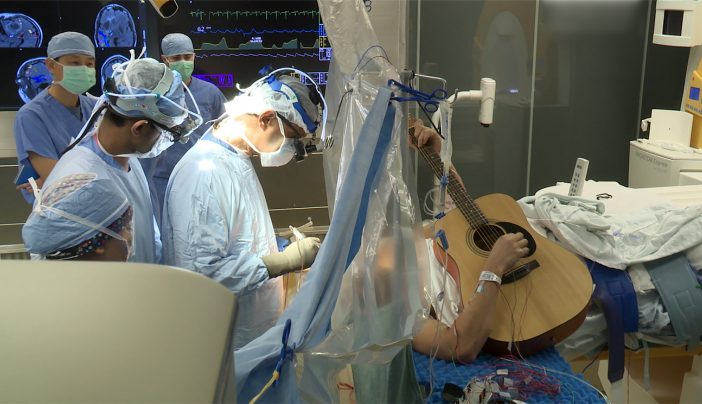Brain Cancer Treatment: How 'Awake Surgery' and Other Innovations are Providing Hope

Share on Pinterest Dr. Shawn Hervey-Jumper, a brain surgeon at the University of California San Francisco, is a specialist in awake brain surgery. Noah Berger for UCSFNew research on brain cancer treatment is providing hope for those with the disease.Among the techniques is the evolving science of awake brain surgery as well as the emerging field of focused ultrasounds.Experts say the White Houses Cancer Moonshot program has helped spur some of the innovations.
Some say outer space is the final frontier. Others insist it is the sea.
But if you ask a cancer brain surgeon, he or she will likely tell you that the real final frontier is the human brain.
Brain cancer remains one of the most confounding cancers to understand and treat.
However, experts say that as researchers learn more about how the brain works, new modalities will follow and bring the brain cancer community new hope. A brain cancer surgeon who is leading the way
Dr. Shawn Hervey-Jumper is a neurosurgeon at the University of California San Francisco (UCSF). His subspecialty is neuro-oncology.
A kind, patient man with a deep but soft-spoken voice, Hervey-Jumper is revered by colleagues. But he remains humble.
Brain cancer will do that to just about anyone.
Hervey-Jumpers work is focused on the surgical management of people with brain tumors that are located in hard-to-reach areas of the brain that are responsible for language, motor, and cognition.
He also serves as the co-director of the Sheri Sobrato Brisson Brain Cancer Survivorship Program, which offers neurosurgery, neuro-oncology, physical medicine and rehabilitation, neuropsychology, and speech pathology multidisciplinary services to adult brain tumor patients. Awake brain surgery
One of the things for which Hervey-Jumper is best known is something called awake brain surgery.
While it may sound frightening, the UCSF surgeon said that once he explains it, people with cancer actually embrace the idea.
Doing the surgery while the patient is awake reduces the risk of damaging critical brain areas that control speech and other skills, Hervey-Jumper told Healthline.
My priority is to provide the best possible surgical care for patients, while also considering rehabilitative therapies to maximize survival and improve their quality of life, he said. Share on Pinterest Dr. Shawn Hervey-Jumper talks with a surgical team at the University of California San Francisco. Noah Berger for UCSF
Awake brain surgery allows the surgical team to map out important areas of the brain to avoid during the surgery to protect the patients language, sensory, and motor abilities as well as communicate with the patient.
If the tumor is near the parts of your brain that control vision, movement, or speech, I will sometimes ask the patient questions and monitor the activity in the brain. We have seen a resurgence in this technique as we learn more about how the brain is organized, Hervey-Jumper said.
My patients are nervous when we tell them about this, but they are also enthusiastic. There are not a lot of cancer patients who get to participate in their own care. The patients do incredibly well. I do these operations 4 to 6 times a week. Changing times in brain cancer research
Dr. James Snyder, a neuro-oncologist with Henry Ford Health in Detroit, told Healthline that brain cancer innovation is accelerating at a rapid rate now because of the dire need for success.
We had to become more creative, said Snyder. We are understanding brain cancer now from many new perspectives. The returns from genomic studies, computer science, machine learning, radiomics, and liquid biopsies, all of these and more are coming to a head and with all that data and insight we have seen a velocity of ingenuity.
He also believes a big part of this progress is the result of the White Houses Cancer Moonshot program.
I attribute many of these advances to the 2015 Cancer Moonshot for putting funding and energy into these new innovations to accelerate progress in cancer outcomes, Snyder said.
Historically, brain cancer treatments have been limited and difficult to navigate in part because of the blood-brain barrier.
That is the network of blood vessels and tissue made up of closely spaced cells that help keep harmful substances from reaching the brain, according to the National Cancer Institute.
The barrier lets some substances, including water, oxygen, carbon dioxide, and general anesthetics, pass into the brain. It also keeps out bacteria and other substances, including some cancer treatment drugs.Promising brain cancer research at Yale
A variety of new techniques are being developed to improve current treatment for brain cancer and other brain diseases.
One of those new modalities being developed by researchers at Yale University in Connecticut deploys tiny bioadhesive nanoparticles to the brain.
The nanoparticles adhere to the site of the tumor and then slowly release the synthesized peptide nucleic acids that theyre carrying, explained W. Mark Saltzman, PhD, a professor of biomedical and chemical engineering as well as cellular and molecular physiology at Yale.
Saltzman told Healthline that these nanoparticles can carry drug and gene delivery into tumors.
On the good side, were seeing lots of good work going on at reputable labs around the world and they are showing advances in treatment in animals. The challenge is moving it to the next stage, he said. Focused ultrasounds being studied
Another relatively new modality is focused ultrasound.
According to UVA Health in Virginia, this technique hits cancer cells with a drug that sensitizes them to sound waves, then blasts them with a focused ultrasound.
The sound waves create tiny bubbles inside the cancer cells, causing them to die.
Clinical trials are showing positive results in temporarily and reversibly opening the blood-brain barrier.
This technology has not yet been approved for the brain.
John Grisham, the bestselling author who has sold more than 300 million books worldwide, published a book in 2016 called The Tumor about focused ultrasound.
The book has two endings. In the first, the lead character is treated with radiation and lives less than a year.
In an alternative ending, the lead character lives between 5 to 10 years because he chooses to be treated with focused ultrasound.
Grisham, whos on the board of the global Focused Ultrasound Foundation, told Healthline that I have often said that The Tumor is the most important book Ive ever written because it has the potential to impact so many.
When I wrote the fictional story about a young father with a deadly brain tumor, I described his current treatment options and then fast-forwarded 10 years into the future, when noninvasive focused ultrasound could potentially rewrite his story with a better outcome, he said.
Since the book was released, focused ultrasound for brain tumors has become more common in clinical trials.
It has been incredibly exciting to see the technology evolve to where we are today. There are ongoing clinical trials around the world using focused ultrasound to temporarily and reversibly open the blood-brain barrier in brain tumor patients, Grisham said.Other brain cancer clinical trials
In December, Insightec, a global healthcare company focused on deploying acoustic energy to transform patient care, announced the LIBERATE clinical trial of liquid biopsy with low-intensity ultrasound in brain tumors.
The trial kicked off an international effort to assess the safety and efficacy of the companys focused ultrasound platform to temporarily disrupt the blood-brain barrier and enable liquid biopsies in patients with glioblastoma.
The first participants were enrolled in the United States and Canada at the Mayo Clinic in Rochester, Minnesota, and at Sunnybrook Health Sciences Centre in Toronto.
Our team at Mayo Clinic is excited to have enrolled the first patient in this pivotal trial, Dr. Terry Burns, a neurosurgeon at the Mayo Clinic, said in a press statement.
If successful, this work has the potential to substantially decrease the rsk of obtaining the initial diagnosis. Importantly, FUS can be repeated non-invasively, allowing a rare molecular window into individual patients brain tumors as they evolve during treatment, Burns said.

